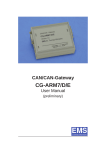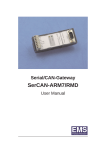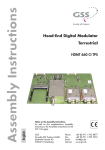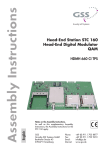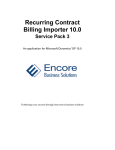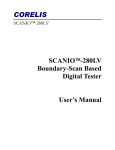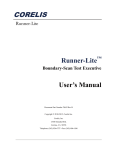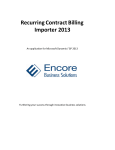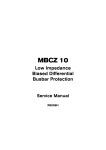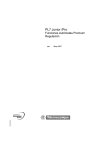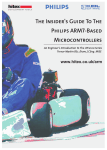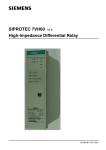Download EMS CG-ARM7 User manual
Transcript
CAN/CAN-Gateway CG-ARM7/RMD User Manual EMS THOMAS WÜNSCHE Sonnenhang 3 D-85304 Ilmmünster Tel. +49-8441-490260 Fax +49-8441-81860 CAN/CAN - Gateway CG-ARM7/RMD User manual CG-ARM7/ RMD Document version: 2.00 Documentation date: June 22nd, 2005 No part of this document or the software described herein may be reproduced in any form without prior written agreement from EMS Dr. Thomas Wünsche. For technical assistance please contact: EMS Dr. Thomas Wünsche Sonnenhang 3 D-85304 Ilmmünster Tel. +49-8441-490260 Fax +49-8441-81860 Our products are continuously improved. Due to this fact specifications may be changed at any time and without announcement. WARNING: ii EMS hardware and software may not be used in applications where damage to life, health or private property may result from failures in or caused by these components. User Manual CG-ARM7/RMD CAN/CAN - Gateway Table of contents 1 Overview . . . . . . . . . . . . . . . . . . . . . 1 1.1 Features . . . . . . . . . . . . . . . . . . . . . 1 1.2 General description . . . . . . . . . . . . . . . . 1 1.3 Ordering information . . . . . . . . . . . . . . . 1 2 Handling . . . . . . . . . . . . . . . . . . . . . 2 2.1 Connection . . . . . . . . . . . . . . . . . . . . 2 2.2 Operation . . . . . . . . . . . . . . . . . . . . . 2 2.3 Configuration . . . . . . . . . . . . . . . . . . . 2 2.3.1 Configuration file . . . . . . . . . . . . . . . . . 3 2.3.2 Programming the device . . . . . . . . . . . . . 9 2.4 Display . . . . . . . . . . . . . . . . . . . . . 12 3 Technical specifications. . . . . . . . . . . . 14 3.1 Pin assignment . . . . . . . . . . . . . . . . . 14 3.2 Limiting values . . . . . . . . . . . . . . . . . 15 3.3 Nominal values . . . . . . . . . . . . . . . . . 15 4 Appendix . . . . . . . . . . . . . . . . . . . . 16 4.1 Configuration file sample . . . . . . . . . . . . 16 4.2 Standard baudrates . . . . . . . . . . . . . . . 17 User Manual iii CG-ARM7/RMD 1 CAN/CAN - Gateway Overview 1.1 Features • Connection of two physically separated • • • • CAN networks Filtering and mapping of identifiers Bus activity displayed by LED Gateway configuration via RS232 or CAN Wiring using a multiway connector 1.2 General description The CAN/CAN gateway CG-ARM7 connects two physically divided CAN networks. The capability of having individual baudrates on both segments, enables routing between them. The filtering of single identifiers or ranges of identifiers lessens the busload. The mapping of single or ranges of identifiers qualifies CG-ARM7 to be used under difficult higher level protocol conditions. The device is configured via serial interface or via CAN network. Due to the intuitive structure of the configuration file in ASCII format, programming and administration is very easy. 1.3 Ordering information 12-20-401-10 User Manual CG-ARM7/RMD 1 CAN/CAN - Gateway 2 CG-ARM7/RMD Handling 2.1 Connection The CG-ARM7 possesses a multiway connector for flexible wiring of the CAN interfaces and the power supply. The RS232 interface on the device is used for programming and for the output of diagnostic information. For normal operation it is not required. The connector assignment of the multiway connector and the RS232 interface is located in chapter “3.1 Pin assignment” in this manual or on your devices front panel. 2.2 Operation To start up the gateway just connect the power supply, the device starts automatically. As soon as the automatic diagnostics is completed successfully, the green power LED lites up permantly. Important note: Ex factory the device offers no configuration and must be configured before it is first run. Configuration instructions for the gateway are located in chapter “2.3 Configuration”. 2.3 Configuration The gateway configuration process consists of two steps: • Creating a configuration file 2 User Manual CG-ARM7/RMD CAN/CAN - Gateway • Storing the configuration file into the gateway 2.3.1 Configuration file The configuration file is a text file with the extension *.gcf. This file holds all data needed by the gateway for operation. A complete sample configuration is located in chapter “4.1 Configuration file”. The values can either be entered in decimal or hexadecimal notation. Using the hexadecimal notation, put the character “x” directly before the particular value. There are two types of parameters, general parameters and routing settings. General parameters include operating information for the gateway. Routing settings are used for mapping and filtering of identifiers. Some parameters are optional. If they are not defined, the gateway uses default settings. Simultaneous programming of several devices is not possible. It must be guaranteed, that each device can be clearly identified. In the following all parameters are listed and described. # comment The configuration file can be provided with comments. Comments are prefaced with the character “#” and they end with the particular line. User Manual 3 CAN/CAN - Gateway CG-ARM7/RMD Example: # 1st comment key = value # 2nd comment version version The gateway requires a version number to identify the programmed configuration. The version number for the CG-ARM7 standard version is 1. This key must exist in each configuration file. Important: The version is not the version of the configuration! The version display what kind of configuration is be loaded! Example: version = 1 btr bit timing The bit timing key indicates the speed of the particular CAN channel. BTR1 indicates the baud rate for CAN channel 1, BTR2 the baudrate for CAN channel 2. Both keys must exist in each configuration file. This keys are directly related to the CANBTR registers of the used controller LPC2119. This allows most flexible customization of the baudrate settings. The basic can clock is 48 MHz. Example: # CAN channel 1: 1Mbit/s btr1 = x00140005 # CAN channel 2: 500KBit/s btr2 = x001C0005 4 User Manual CG-ARM7/RMD CAN/CAN - Gateway Standard speeds recommend by CiA are located in chapter “4.2 Standard baudrates”. pidin, pidout program identifier The program identifiers (PIDs) are required for the gateway configuration via CAN. If you do not want to program the gateway via CAN, you can remove this keys from your configuration file. The PIDs determine which identifiers will be used for programming the gateway. “pidin” defines the identifier the configuration software uses to send requests to the gateway. The key “pidout” defines the identifier which the gateway uses to reply to the configuration software. For CAN channel 1 and CAN channel 2 different PIDs can be set. But it is also possible to program the gateway just via one CAN channel. To set the wanted identifiers for CAN channel 1 use the keys “pidin1” and “pidout1”. For CAN channel 2 use the keys “pidin2” and “pidout2”. To use a 29-bit identifier prepend the character “x” before the particular key. Without prefix before the key 11-bit identifiers will be sent. Example: # PIDs for CAN channel 1 # CAN 1: 11-bit IN-Id: 0x5 pidin1 = x5 # CAN 1: 29-bit OUT-Id: 0xA00 xpidout1 = xA00 User Manual 5 CAN/CAN - Gateway CG-ARM7/RMD # PIDs for CAN channel 2 # CAN 2: 29-bit IN-Id: 0x6E xpidin2 = x6E # CAN 2: 29-bit OUT-Id: 0x1FFE xpidout2 = x1FFE name configuration label For easier identification of the programmed settings, the configuration can be labeled. The configuration name must not have more than 32 characters and must not contain space characters or tabs. If this key is missing, no name will be assigned to the configuration. Example: name = standard_configuration deviceid device id During the configuration process via CAN the device has to be uniquely selected in the network. This process is based on the serial number of the device. If there is the need to have the configuration process independent of the serial number, a device id can be assigned. Then the identification of the device depends on the device id and not on the serial number. Care must be taken to use a particular device id just once in a network, if more than one gateways is used. The device id can have values between 1 and 99999999. Example: deviceid = 50 6 User Manual CG-ARM7/RMD CAN/CAN - Gateway busoff bus off behavior This key defines the period in milliseconds, which shall be waited until the gateway gets bus on again after a bus off condition has occured. If this value is not defined, the device remains in bus off state. If a bus off time of 0 milliseconds is set, the gateway tries immediately to get bus on again. Example : busoff = 100 password password Using a password, the gateway can be protected against unauthorized access. If the key is not defined or the value is set to 0, password protection is disabled. The password is an up to 14-digit hexadecimal value. The password protection supports two security levels. For the highest security level the highest bit (56th bit) of the password must be set to 1. This security level prevents any communication with the gateway, if the device has not been unlocked with the correct password before. At the normal security level, the highest bit (56th bit) is 0. Read out of information about the gateway and the configuration is enabled. Changing the configuration however is not possible! Example: # Security: high User Manual 7 CAN/CAN - Gateway CG-ARM7/RMD password = 80 07 05 AF D6 B0 D1 # Security: normal password = 00 07 05 AF D6 B0 D1 fil routing The routing settings contain the filtering and mapping rules for a single identifier or ranges of identifiers. Only stated identifier or ranges of identifiers are transmitted and, if existent, the adequate mapping rule is applied. All incoming messages with identifiers to which no rule applies are ignored (defined program identifiers excepted). Additionally the frame format must be set within the filtering rules. Key structure: Different from the basic keys, the routing key is constructed in a more complex way. The key specifies 3 criteria: [inff] fil channel [outff] = ... 1. inff: Defines the frame format for incoming messages. The frame format for incoming messages specifies whether the filtering rule is applied to standard or extended messages. If inff is set to ‘s’ standard frame format is specified. When set to ‘x’ the extended frame format is defined. 2. channel: Defines the channel number. The channel number specifies whether the filtering rule is applied to incoming messages on CAN channel 1 or on CAN channel 2. 8 User Manual CG-ARM7/RMD CAN/CAN - Gateway 3. outff: Defines the frame format for outgoing messages. The frame format for outgoing messages specifies whether the result of the filtering rule is sent via standard or extended identifier. If outff is set to ‘s’ standard frame format is specified. When set to ‘x’ extended frame format is defined. Structure of the filtering rule: Now that the key defines to which message the rule applies, further selections have to be made. The filtering rule in turn specifies 3 criteria: … = sid [- eid] [: mid] 1. sid: Defines the identifier the filtering rule is applied to. If a range of identifiers is defined, sid is the start identifier. If the prefix ‘x’ is before the value the identifier is interpreted as a hexadecimal number. 2. eid: Defines the end identifier for ranges of identifiers. If no range of identifiers is used, the value is not needed. If the prefix ‘x’ is before the value the identifier is interpreted as a hexadecimal number. 3. mid: Defines the mapping identifier. The mapping identifier states the start identifer, to which the single identifier or the range of identifiers is mapped. Should the identifiers not be mapped it is not needed to set this value. If the prefix ‘x’ is before the value the identifier is interpreted as a hexadecimal number. User Manual 9 CAN/CAN - Gateway CG-ARM7/RMD Example: # The via CAN channel 1 # received extended # identifiers in the range # of 0x30 to 0x40 are # sent via CAN channel 2 # as standard identifiers in # the range of 0x400 to # 0x410. xfil1s = x30 - x40 : x400 # The via CAN channel 2 # received extended # identifier 0x1FFFFFFF # is sent via CAN channel 1 # as extended identifier # with the value 0x01. xfil2x = x1FFFFFFF : x1 # The via CAN channel 1 # received standard # identifiers in the range # of 0x100 to 0x200 are # sent via CAN channel 2 # as standard identifiers # in the range of 0x100 # to 0x200. sfil1s = x100 - x200 2.3.2 Programming the device CG-ARM7 is programmed by means of the configuration software. It offers the possibility to configure the gateway via serial connection or via CAN. For the configuration a serial cable or a PC-CAN interface of EMS Dr. Thomas Wuensche is needed. 10 User Manual CG-ARM7/RMD CAN/CAN - Gateway Setting up the PC interface: The PC interface is set in the upper left field. First you choose, if the gateway shall be accessed via RS232 or via CAN interface. If the configuration software recognizes, that you do not use an interface of EMS Dr. Thomas Wuensche you can not select CAN as your interface. Next the PC interface with which you want to connect to the CG-ARM7 has to be chosen. If you have selected RS232 as interface before, you set up the COM interface here. If you have chosen CAN, you select your CAN interface here. Speed can only be selected, when a connection via CAN has been made. Choose a standard baudrate compliant to the CiA or choose “Custom” to insert a user defined setting. Your selected baudrate must be the same as the baudrate of the gateway. If no configuration is in the gateway it is not possible to communicate with the gateway via CAN. User Manual 11 CAN/CAN - Gateway CG-ARM7/RMD Process selection: In the right upper field of the configuration software you choose the process, you want to perform. • Program new configuration • • With this process you can program a new configuration to the device. Before starting you have to select the configuration you want to write to the gateway. Remove configuration from device This process deletes the current configuration on the CG-ARM7. Afterwards the gateway is in delivery state again. It is not needed to delete the configuration before a new one is programed, as this is done automatically. Read device information Here information about the gateway and the configuration within can be read out. 12 User Manual CG-ARM7/RMD CAN/CAN - Gateway Optional device settings If the CG-ARM7 is password protected, you must activate the field “password” and fill in the correct password. Depending on the security level, it is possible to request information about the device even without password. If CAN has been chosen as the PC interface the “Inbound Program Identifier” (pidin), the “Outbound Program Identifier” (pidout) and the frame format for the program identifiers have to be set. At last the serial number or the configured device id of the device has to be inscribed for explicit identification. If you use only one gateway in the network, you can also inscribe the value ‘0’ here. Never use the value ‘0’, if there are more than one CG-ARM7 gateways in the network. Starting the download: To start the download process press start. The operation may take a while, do not disconnect the power supply to the device during the configuration process. At that time the routing functionality of the gateway is deactivated. After successful completion no status message is displayed. If an error occures a status message is displayed. 2.4 Display The device status is displayed by three LEDs. Power On User Manual The device is in normal operation mode. Routing of CAN messages is enabled. 13 CAN/CAN - Gateway CG-ARM7/RMD The device is in programming mode. Blinking Routing of CAN messages is disabled. CAN 1 Active On There is bus activity on CAN 1. CAN 2 Active On 14 There is bus avtivity on CAN 2. User Manual CG-ARM7/RMD 3 CAN/CAN - Gateway Technical Data 3.1 Pin assignment Pin assignment of the multiway connector Pin Signal Description 1 +24V +24 Volt power supply 2 GND Ground* 3 GND Ground* 4 CAN1-H CAN1-High Buswire 5 CAN1-L CAN1-Low Buswire 6 GND Ground* 7 CAN2-H CAN2-High Buswire 8 CAN2-L CAN2-Low Buswire * Internal connected Pin assignment RS232 Pin Signal 2 RxD Receive signal 3 TxD Transmit signal not connected 4 5 GND 6 Ground not connected 7 RTS not used 8 CTS not used 9 User Manual Description not connected 1 not connected 15 CAN/CAN - Gateway CG-ARM7/RMD 3.2 Limiting values Stresses above the specified values can lead to permanent damage of the CG-ARM7. Parameter Min. Max. Unit Storage temperature -20 80 C 0 60 C -100 30 V Operating temperature Supply voltage Note: With respect to methods of measurement it is not possible to have ESD protection circuits at the CAN terminals. ESD protection on this terminals is determined by the ESD capability of the used CAN transceiver (Philips 82C251). 3.3 Nominal values Parameter 16 Min. Max. Unit Supply voltage 10 30 V Baudrates 10 1000 kBit/s User Manual CG-ARM7/RMD 4 CAN/CAN - Gateway Appendix 4.1 Configuration file example # Gateway CG-ARM7/RMD configuration file # Baudrate CAN interface 1 - 1000 kbps btr1=x00140005 # Baudrate CAN interface 2 - 500 kbps btr2=x001C0005 # Version number of configuration file version=1 # Device ID deviceid=120000 # Set bus off recovery time to 1000 ms busoff=1000 # Password protection: security level # normal password=11 AA 33 BC # Configuration name name=router # Program identifier CAN channel 1 pidin1=x1 # Standard identifier 0x01 xpidout1=x2 # Extended identifier 0x02 # Program identifier CAN channel 2 xpidin2=x10 # Extended identifier 0x10 xpidout2=x20 # Extended identifier 0x20 # Filter settings User Manual 17 CAN/CAN - Gateway CG-ARM7/RMD # All standard identifiers from CAN channel # 1 are sent as standard identfiers to CAN # channel 2 sfil1s=x0-x7FF # All standard identifiers form CAN channel # 2 are sent as standard identifiers to CAN # channel 1 sfil2s=x0-x7FF # All extended identifiers form CAN channel # 1 are sent as extended identifiers to CAN # channel 2 xfil1x=x0-x1FFFFFFF # All extended identifiers form CAN channel # 2 are sent as extended identifiers to CAN # channel 1 xfil2x=x0-x1FFFFFFF 4.2 Standard baudrates Speeds recommended by CIA: Baudrate 1000 kbps 800 kbps 500 kbps 250 kbps 125 kbps 100 kbps 50 kbps 20 kbps 10 kbps 18 Bit Timing Register 0x00140005 0x00160005 0x001C0005 0x001C000B 0x001C0017 0x001C001D 0x001C003B 0x001C0095 0x001C012B User Manual CG-ARM7/RMD CAN/CAN - Gateway THIS PAGE INTENTIONALLY LEFT BLANK User Manual 19






















